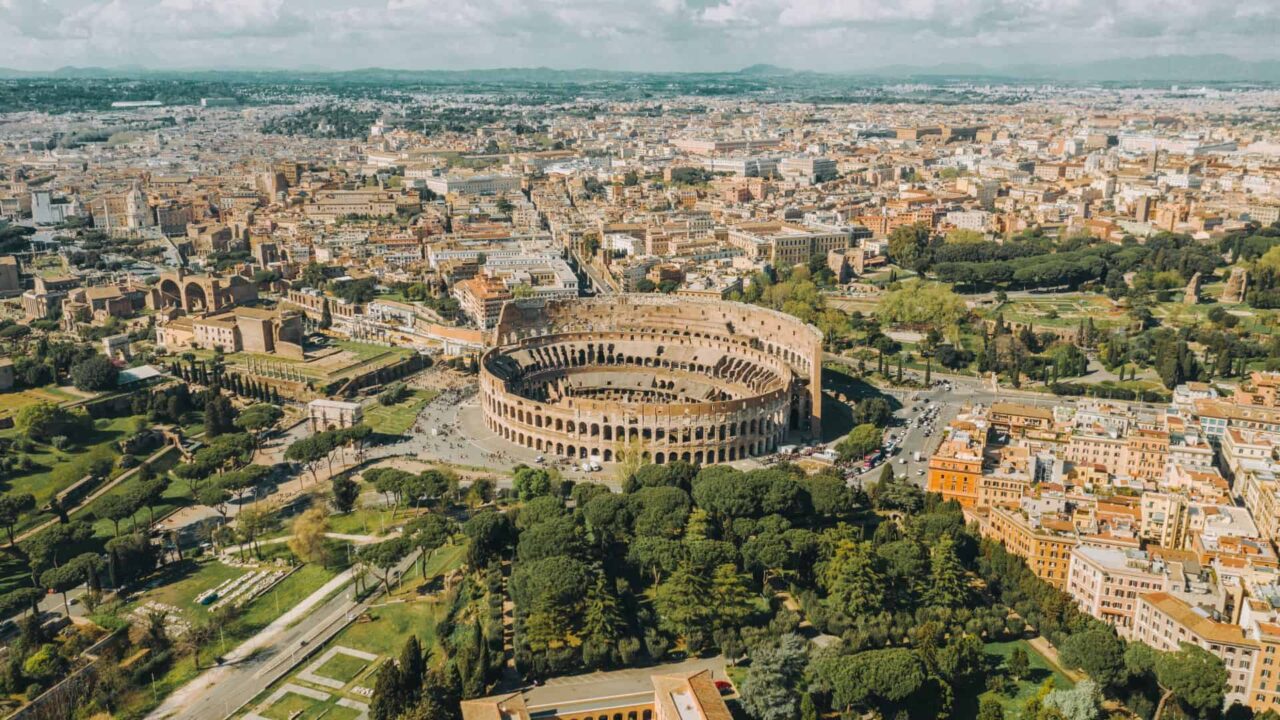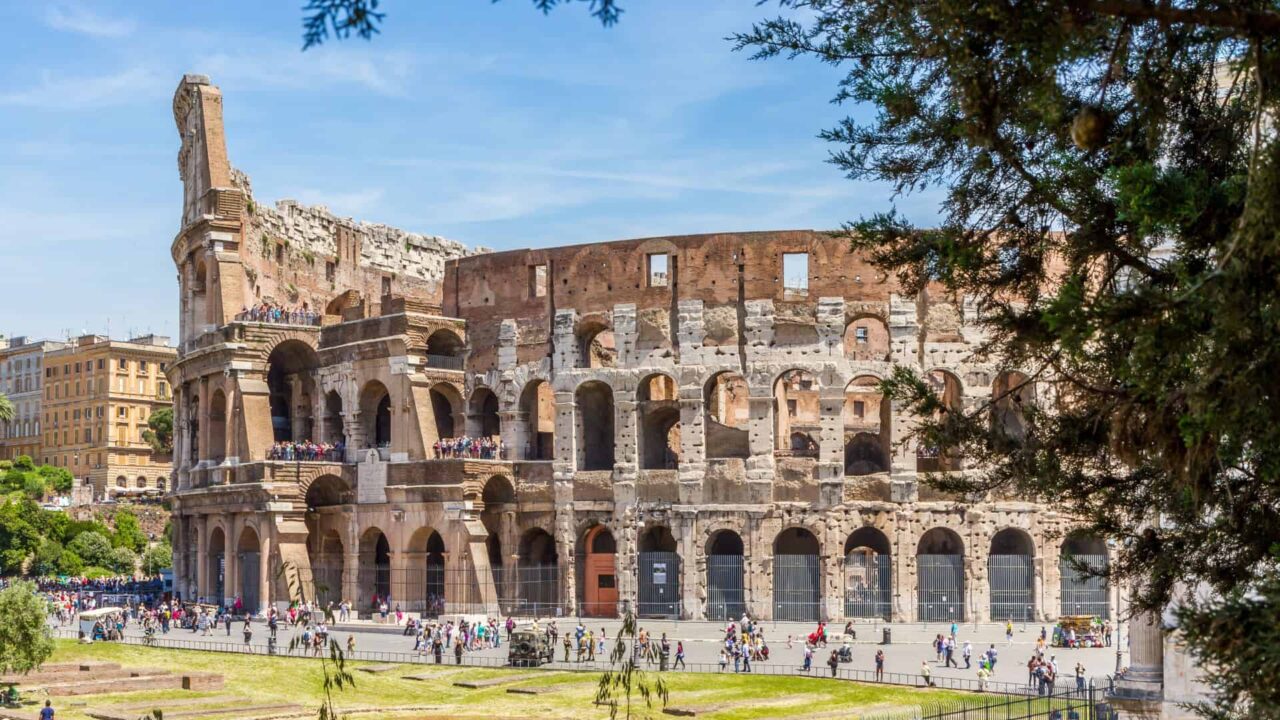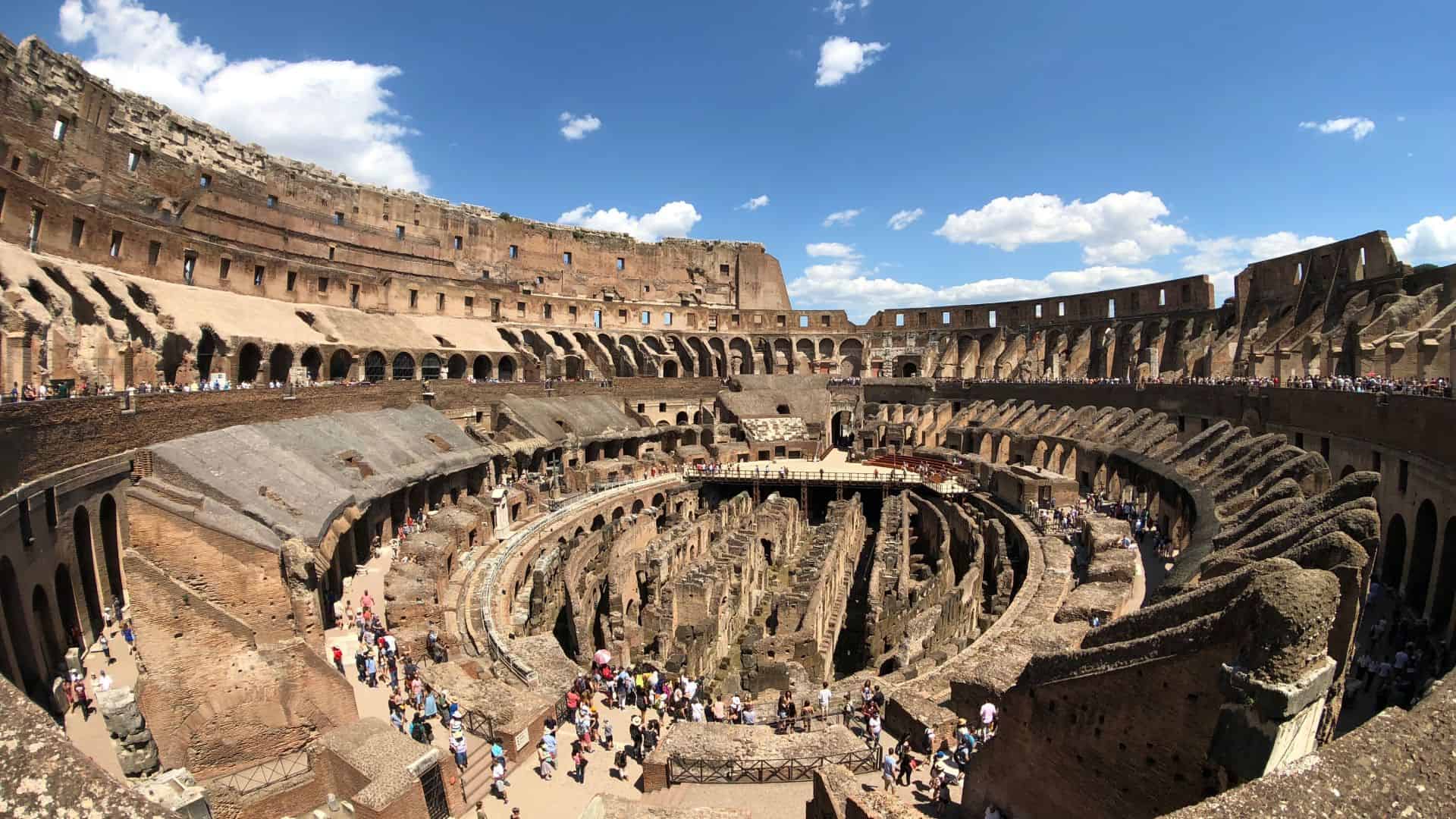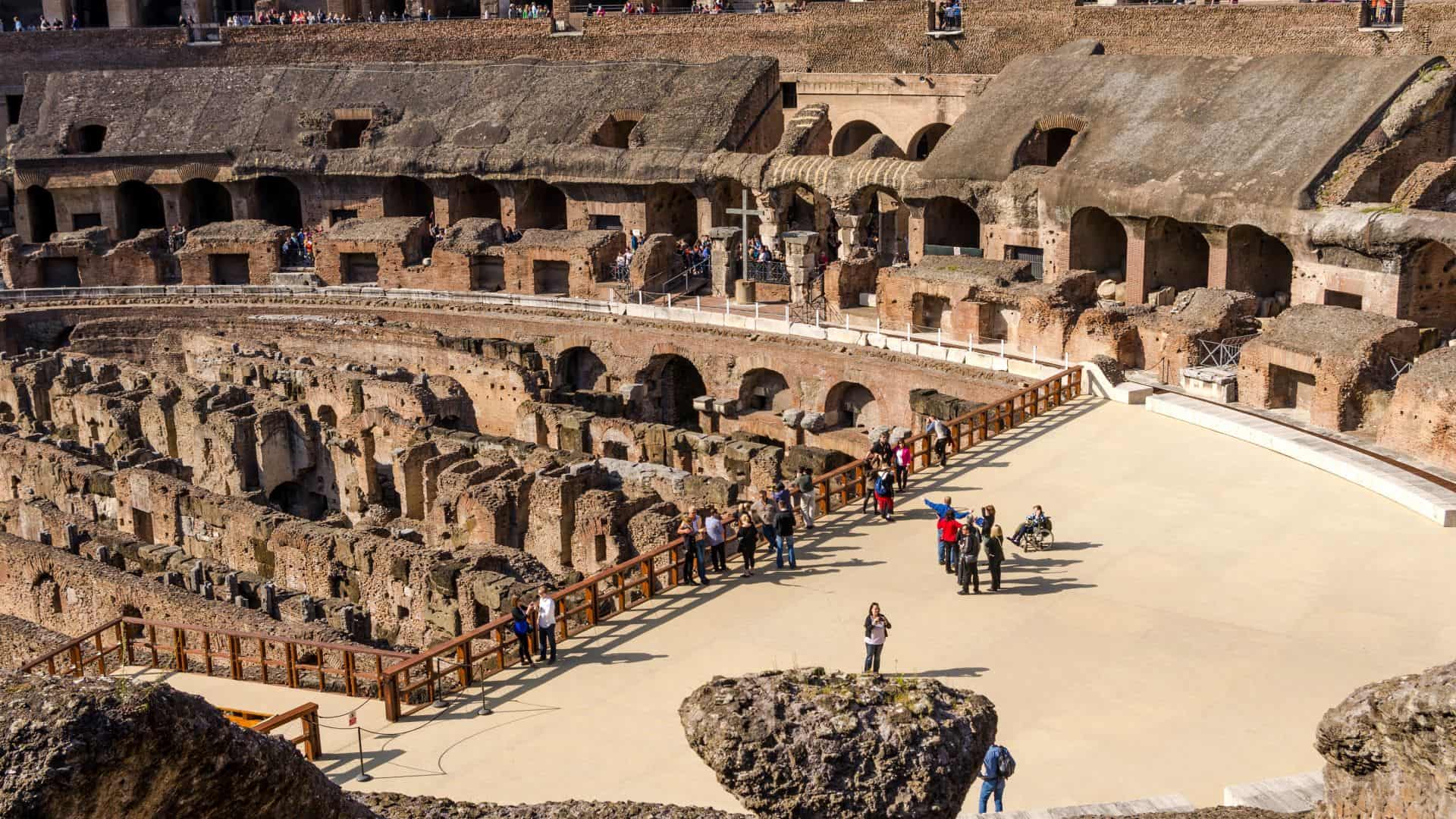Uncover the secrets of the gladiators at the Roman Colosseum.
Step into two thousand years of history as you explore the most iconic symbol of the ancient world in Rome: the Colosseum.

Highlights
- Enter into the stands and imagine the roar of 50,000 spectators as the emperor decides who lives or dies.
- Follow in the footsteps of gladiators and step out onto the arena floor.
- Delve into the labyrinth below the Colosseum, where the gladiators and wild animals would be kept to await their fates.
Tickets & Prices
Colosseum tickets sell out fast, so we recommend buying your tickets online as early as possible. Here’s a brief overview of the different ticket options:
Option 1: Rome Tourist Pass and combi-tickets
If you plan to visit various attractions in Rome, you could save time and money by buying all the necessary tickets at once:
1a. Rome Tourist Card
This best-selling ticket bundle gives you access to Rome’s most popular tourist attractions:
- The Colosseum, Roman Forum & Palatine Hill
- Vatican Museums & Sistine Chapels
- St.Peter’s Basilica or Castel Sant’Angelo or Borghese Gallery (pick one)
It also includes a Rome audio guide app and you get a 10% discount on other tickets you may want to buy. More info about the Rome Tourist Card ->
1b. Colosseum & Vatican Museum
This combi-ticket gives access to:
- The Colosseum, Roman Forum & Palatine Hill
- Vatican Museums & Sistine Chapels
The Rome audio guide app for your phone is also included. More info about the Colosseum & Vatican ticket bundle ->
Option 2: Colosseum tickets
If you’re only interested in visiting the Colosseum and Roman Forum, your best bet is to have a look at the overview page of all available tickets.
If the basic tickets are sold out, “special” tickets may still be available: tickets that include a guided tour, multimedia show, or Arena-access for example.
We recommend looking on both Tiqets and GetYourGuide to increase your chances of finding a ticket for your visit dates.
If you’re traveling with a group of 10+ people, you might be able to get discounted tickets. Send your request to groupsightseeing.com
Option 3: Roman Ruins Pass
Even if the Roman Colosseum is sold out, you can still visit the neighboring ancient sites with the Roman Ruins Pass. This ticket bundle gives you access to:
- Single entrance for the Roman Forum
- Single entrance for Palatine Hill
- Single entrance for Imperial Forum
- Entrance to Palatine Museum, House of Augustus, Neronian cryptoporticus, Santa Maria Antiqua, Ramp of Domitian, Oratory of the Forty Martyrs, Curia Julia and Domus Tiberiana
- Roman Ruins: Smartphone Audio Guide
More info about the Roman Ruins Pass ->
What to see and do
To help you understand what a visit to the Colosseum entails, we have broken down its most popular attractions.
Colosseum Outer Wall

Your experience begins before you ever set foot inside: the first sight of the Colosseum is always special. The crumbling ruin of the south side gives way to the imperious magnificence of the stunning north side.
The ornate structure is 57 metres tall, built using travertine marble sourced from quarries around Italy. It is almost tradition to pose gleefully outside the Colosseum when visiting Rome – the photo op might be cliché, but it is a memory you will undoubtedly treasure forever.
The Second Floor

See the arena from above as you walk around the amphitheater. The second floor of the Colosseum would have been reserved for the wealthiest, most important members of Ancient Roman society.
You can see the Colosseum from the spectators’ perspective high above the arena. Marveling at the sheer size of the structure, the ornate stonework and general sense of greatness is all part of the experience.
There are small exhibits and information points on the second floor. You can discover more about the Colosseum’s history while admiring the ancient artefacts unearthed during archealogical digs.
Arena

Entering the arena is both an awe-inspiring and chilling experience. Standing where so much blood has been shed and thousands of lives were lost is humbling – it is easy to envision a time thousands of years in the past, where people were fighting for their lives in the sand, under the watch of 50,000 frenzied spectators.
From the arena floor you can get a closer look into the Hypogeum, and enjoy a unique perspective peering into the maze of tunnels below.
Gate of Death
If you have access to the arena floor, you will walk through the Gate of Death. The rather gruesome purpose of this gate was to ferry the dead bodies of defeated gladiators and executed prisoners out of the arena.
The Gate of Life was located on the opposing eastern side. This is where the gladiators would enter the arena before a battle.
Underground (The Hypogeum)
The most mysterious and fascinating part of the Colosseum is, without doubt, the Hypogeum. For years, archaeologists avoided the labyrinth of tunnels due to its sheer complexity, and it has only been fully opened to visitors since 2021.
The ‘backstage’ of the games is where the gladiators would prepare for battle, and wild animals were kept. You can see previously hidden secrets when wandering the Hypogeum; like the trap doors used to raise lions and other predators into the arena from below.
The Arena, Gate of Death and Hypogeum are special access only; they’re not included in the basic ticket price.
Did you know that: (4 Interesting Facts!)
- Everyone knows about the wild animal hunts and gladiator fights. But did you know that the Colosseum was once the setting of naval battles? Emperor Titus ordered the Colosseum to be flooded to allow a reenactment of an ancient sea battle between Athens and Syracuse to take place.
- The Colosseum was originally known by its official name, the Flavian Amphitheater. It is believed the name Colosseum derives from the ampihitheater’s proximity to the Colossus of Nero, a huge bronze statue that once stood nearby.
- In 2007, the Roman Colosseum was chosen as one of the ‘New Seven Wonders of the World’.
- Tickets to the largest spectacles were often free – they were usually paid for by the emperors to keep public morale high.
History
An almost 2000 year long timeline of the Roman Colosseum:
- AD 70-72. Construction of the Colosseum begins under the authority of Vespasian, the founder of the Flavian dynasty.
- AD 80. The Colosseum opens with great fanfare. The son and successor to Vespasian, Titus, kicks off 100 days of games in celebration.
- AD 82. Final touches are added to the Colosseum. The upper stand is completed during the reign of Domitian.
- AD 404. The rise of Christianity makes the games fall out of style. The last gladiatorial fight in Rome takes place at the Colosseum.
- AD 523. The last staged hunt, or venatio, is recorded.
- AD 1349. A huge earthquake causes untold damage to the Colosseum. The entire outer shell of the south side collapses, leaving behind the iconic ruin we see today.
- AD 1750. After centuries of looting and neglect, Pope Benedict XIV declares the Colosseum a ‘sacred place’ and forbids any further damage. Small restoration work begins.
- AD 1800 onwards. Restoration work begins in earnest. A fascination with antiquity in the 19th century prompts archaelogical digs and reconstruction work.
- 1990s. Modern technology and techniques are used in an attempt to restore the Colosseum to its former glory. The work continues to this day.
- Present Day. The Roman Colosseum is one of the most recognizable tourist attractions in the world. It welcomes over six million visitors every year.
Map & Directions
The Colosseum is located in the centre of Rome, at the Piazza del Colosseo.
Head to in the heart of Rome.
If using the metro: take the Linea B metro line, and get off at the ‘Colosseo’ station.
Address: Colosseum, Piazza del Colosseo 1, 00184 Roma, Italy · view larger map